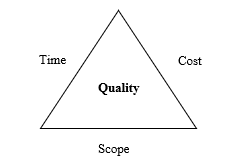As we develop as a society, our infrastructure evolves. Our country boasts the largest natural asphalt lake in the world and we are home to scores of government and privately owned quarries with sand, quartzite and limestone aggregates. We are as such, poised to provide material for our local construction needs. But are we really? With the many competing interests for our locally available resources to create and maintain critical facilities such as emergency shelters and emergency first response, communication sites and systems, transportation systems and relief and recovery there appears to be a greater demand than supply.
Roads, buildings, bridges, dams and piers all require some level of design, and for successful completion and implementation we need to be confident in their design, construction, and the quality of materials used in them. By quality of the materials we mean at minimum their resistance, strength, integrity and durability.
Consider briefly the diagram below, referred to as the Project Management Triangle. Each side represents a core component of a project. By varying any of the components of the project the others need to be adjusted to maintain quality.

For instance if the scope of works on a construction project is increased, the cost or time for completion also changes to maintain quality. Similarly a change in the time for completion would affect the other components. One our biggest questions is: How do we meet the challenge of limited or depleting resources to meet the needs of the industry and achieve maximum benefit? The answer should include proper: planning and design, resource management and quality assurance and quality control.
By testing construction materials prior to construction we can determine whether they meet the minimum performance requirements for the intended application and assess the effectiveness of the process used to bring it to a usable state. Typically a project would be guided by a set of documents, one of which is the Specification Document which states the requirements for the materials and the construction processes. This document is important in interpreting the results of materials testing. Equally important is ensuring that the materials assessed for use in the project are in fact the materials used in the manner as designed. Careful monitoring is required.
The use of materials that do not conform to the requirements of the Specification can be detrimental and lead to a series of issues. Amongst these are:
- Defects in the construction
- Unsafe conditions during construction
- Reduced capacity of the structure
- Decreased durability of the structure / shorter life
- Failure of structure in service
- The need testing or inspection to determine extent of defect which could lead to delays or re-design
- Re-work which can include removal of in-place material and replacement at contractor’s expense
- Time delay in completion of project
- Increase in cost due to testing, inspection, re-work, downtime, additional labour or resources to bring the project back on schedule
- Wastage of resources (labour, material, equipment, time)
- Loss in reputation of contractor or supplier
Especially in a time where there are many competing interests for materials it is prudent that we manage the resources and funds to ensure that they are placed to the most appropriate use.
It is important that testing and inspections be conducted by competent personnel. Accredited labs that maintain a quality management system focus on having trained and competent personnel using the right methods and equipment to conduct testing.
For more information on our laboratory and field testing services for industry:
- Visit our website: www.cariri.com
- Tel: 299-0210 ext 3190/3502/3600
- Email: imu@cariri.com




